Learn
A New Government Is Born
Purposes of the Constitution
The delegates to the Constitutional Convention agreed upon five purposes to fulfill in an effort to create an effective constitution for the new nation:
- Establish legitimacy: The framers had to establish that the new government was a legitimate one with a "right to rule". There had to be a contract between the government and those who are governed ... "We the people of the United States..."
- Create appropriate structures: The second purpose was to create appropriate structures within the new government to fulfill the goal of representative democracy and ensure that the state government and national government would share power.
- Describe and distribute power: The framers recognized that they would need to describe governmental powers and distribute them among the structures they created.
- Limit government powers: The framers wanted to limit the powers of the structures they created, so there are limits placed on the powers of Congress, as well as on state governments.
- Allow for change: The framers' final purpose was to include a way to change the Constitution, if needed. This was to ensure that the document could change with the times, without making the system unstable from too many changes.
The Preamble
"We the People of the United States, in Order to form a more perfect Union, establish Justice, insure domestic Tranquility, provide for the common defence, promote the general Welfare, and secure the Blessings of Liberty to ourselves and our Posterity, do ordain and establish this Constitution for the United States of America."
The goals of the Constitution are laid out in its introduction, the Preamble. The first three words in the Constitution, "We the people," are the basis for the rest of the document. It is the people of the United States who govern!
"We the people of the United States...ordain and establish" fulfills the first purpose of the framers to ensure that the new government's legitimacy and power came from the American people instead of the states. This was a problem with the Articles of Confederation.
Throughout this lesson, we are going to be reading through the interactive U.S. Constitution. You've already read the Preamble to the Constitution above. Next, read about the common interpretations of the Preamble.
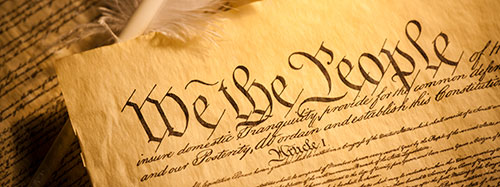
The Federal System
The framers wanted to create a system of shared power, or a federal system, to divide power between the state and federal governments.
This system of concurrent powers helped the framers fulfill their second purpose (creating appropriate structures within the government to ensure the sharing of power) and their fourth purpose (limiting government powers by sharing them between the states and national government).
Both the states and federal governments have separate, specific powers, but they also share certain powers, such as imposing taxes and regulating banks.
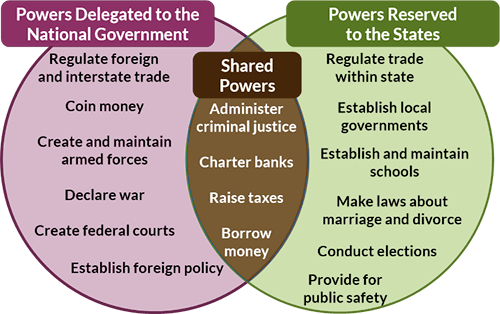
Separation of Powers
The Constitution further separated powers into the three branches of government: legislative, executive, and judicial.
- The legislative branch makes the laws.
- The executive branch carries out the laws.
- The judicial branch interprets the laws.
Each branch plays a vital role in the support of the Constitution. Let's explore the first three articles of the Constitution which established these three branches.
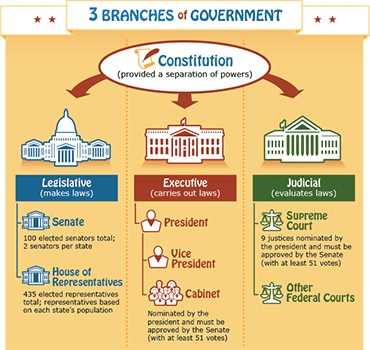
Article 1: The Legislative Branch
The powers of Congress are outlined in Article I of the Constitution. Congress makes up the legislative branch with two houses:
- The House of Representatives which is made up of 435 elected representatives total; the number of representatives per state is based on that state's population
- The Senate, which is made up of 100 elected Senators total; 2 per state
Remember we have a bicameral Congress meaning there are two houses.
The legislative branch makes the laws, and Congress is the most powerful legislative body in the nation! Only Congress can coin money, declare war, raise an army, and regulate commerce the exchange (trade) of goods and services .
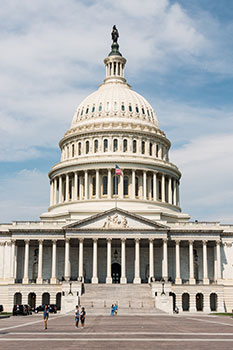
Why does the first article of the Constitution focus on Congress rather than the presidency or the court system? Because the framers wanted to stress the importance of the legislative body. It is the branch that most directly represents the people and is most responsive to the people!
By creating Congress, the framers were also able to fulfill their second purpose of creating appropriate structures within the new government to ensure representative democracy.
The Constitution is based on the principle of popular sovereignty, which is rule by the people. It does not provide for a direct democracy, or a government in which every law would have to be voted on by the people. Instead, the framers chose a representative democracy, or a government in which elected officials represent the constituents of their state or district.
Read Article 1 of the Constitution.
Article 1, Section 8, Clause 18: The Elastic Clause
A statement found in Article 1, Section 8, Clause 18 of the Constitution grants Congress the power to pass all laws it considers "necessary and proper" to carry out its duties. There are already 17 other enumerated powers (or numbered or specifically listed powers) contained in this section. Why do you think the framers included the elastic clause as the final power?
Consider this: The enumerated powers of taxation (Clause 1), borrowing money (Clause 2), regulating commerce (Clause 3), and coining money (Clause 5) all have a lot in common, but they also only imply the power to create a bank. Even the power to create a bank is not explicitly listed in the Constitution, the elastic clause gives Congress the power to do so.
Read The Founders and Federalism to learn about the differences between the three types of power the Constitution grants to the national government – enumerated (or delegated) powers, implied powers, and inherent powers.

Article 2: The Executive Branch
The lack of a strong executive was considered a major weakness of the Articles of Confederation, but there was also concern among the framers about giving one person too much power. Read Article 2 of the Constitution, which established and outlined the powers of the executive branch. Think about following while you read:
- What do you notice about the length of Article 2 compared to the length of Article 1?
- What do you think this difference means?
As you read, Article 2 sets up the president is the executive officer of the executive branch, which carries out or executes the law. The president is established as the commander-in-chief, or overall command of the armed forces. The President's term is four years. There was no limit to the number of times a president could be reelected until the 22nd Amendment was passed in 1951, limiting each president to a maximum of two terms.
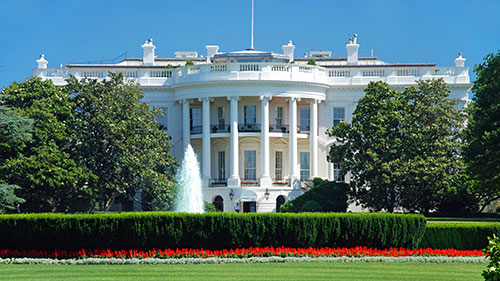
Additional duties of the executive branch include carrying out laws and coming up with a spending plan for the country. They also make treaties, or agreements, with other countries.
Requirements for the Presidency
In order to be elected president, a person must be:
- At least 35 years old,
- A natural-born citizen This means you cannot be president if you were born in another country and immigrated here. Even if you become a naturalized U.S. citizen later, you still cannot be president. of the United States, and
- You must have lived in the United States for the past 14 years.
Read Requirements for the President of the United States to learn about the history of these requirements.
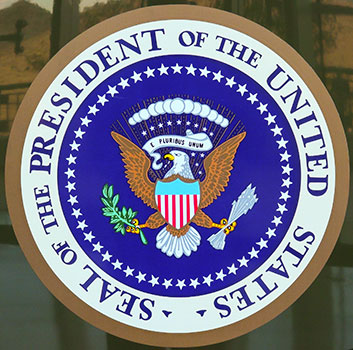
Article 3: The Judicial Branch
Created by Article 3, the judicial branch is in charge of interpreting laws, which means they determine if laws are constitutional, or allowed by the Constitution. It is made up of the federal court system and the Supreme Court, the highest court in the United States.
Supreme Court justices are appointed by the president but must be approved by the Senate. They serve for life, which is an attempt to safeguard their decisions from politics.
Read Article 3 here.
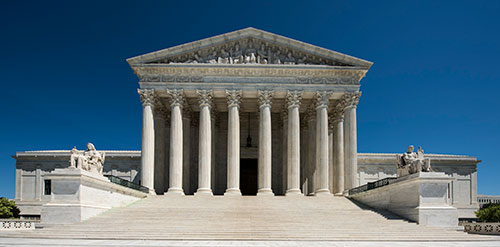
Articles 4-7
Although the remaining articles of the Constitution are important, they are not nearly as detailed as Articles 1-3, nor do they establish any structure of government.
Here is a brief overview of each of the remaining articles:
- Article 4 establishes relations among the states and ensures that citizens of one state will retain their rights in another state.
- Article 5 explains the amendment or modification process for the Constitution.
- Article 6 declares that the Constitution and the laws of the United States are the highest law of the land.
- Article 7 involves the ratification (or approval) of the Constitution. It established that nine of the 13 states would have to ratify the Constitution for it to take effect or be enacted.
System of Checks and Balances
As you have seen in our examination of the Constitution so far, the power is not only shared between the states and the national government, but it is also thoroughly described and distributed among each branch of government. This system of checks and balances allows each branch the ability to limit the power of the other two. This fulfilled the third purpose of the framers to both describe governmental powers and distribute them among the structures they created.

Here's an example of how this system of checks and balances ensures that no one branch gets too powerful and that no branch functions without the cooperation of the others.
Congress can propose legislation and the bill can pass both houses, but a president can veto, or reject the bill. If two-thirds of both houses of Congress agree, they can override a presidential veto. Through court cases, the judicial branch could later find the law unconstitutional not allowed under the Constitution and throw it out. Each branch has powers that the others do not.
Summary
The Constitution of the United States contains a preamble and seven articles that describe the way our government is structured and how it operates.
The first three articles establish the three branches of government and their powers: Legislative (Congress), Executive (office of the president,) and Judicial (federal court system). Read The Three Branches of Goverment to see some modern examples of the different powers each branch holds.
A system of checks and balances prevents any one of these separate powers from becoming dominant.
Articles four through seven describe the relationship of the states to the federal government, establish the Constitution as the supreme law of the land, and define the amendment and ratification processes.